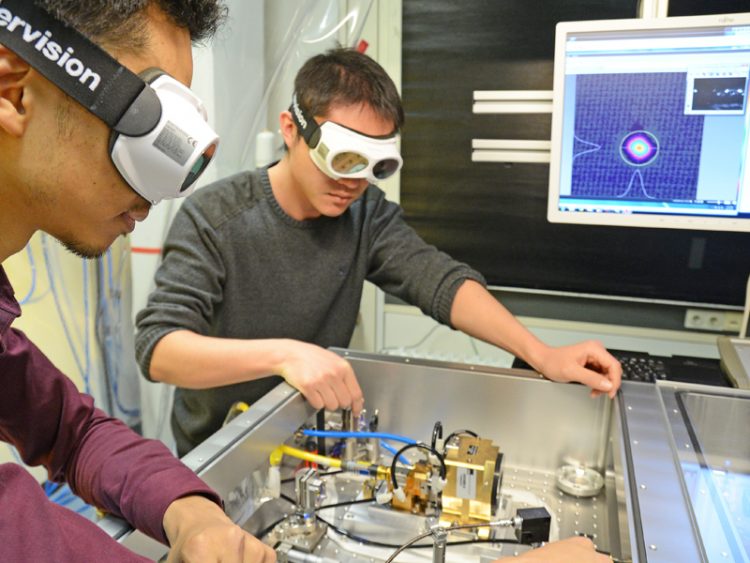A Keen Sense for Molecules

The lasersystem developed by the LMU physicists is the first one worldwide, that produces infrared lightpulses with a power of 19 Watt and wavelengths of about 20.000 nanometres. Photo: Thorsten Naeser
Infrared light has a keen sense for molecules. With the help of this light, researchers are able to go in search of the small particles which shape and determine our lives. The phenomenon, in which infrared light sets molecules in vibration, is pivotal in this search. Scientists are exploiting this phenomenon by using infrared light to analyze the molecular makeup of samples.
In the hope that this analysis can become even more exact, the laser physicists from the Laboratory of Attosecond Physics (LAP) at the Ludwig-Maximilians-Universität (LMU) in Munich and the Max Planck Institute of Quantum Optics (MPQ) have developed an infrared light source that has an enormously broad spectrum of wavelengths. This light source is the first of its kind worldwide and can be used to help detect the smallest amounts of molecules in liquids like blood.
When infrared light encounters molecules, they begin to vibrate. In this process, each particular type of molecule is brought into motion by a very specific set of different wavelengths in the range from 3 to 20 micrometers.
By examining the wavelengths of the light being emitted after this excitation, researchers are able to derive the molecular composition of the sample. The more powerful the source of infrared light and the more wavelengths utilized, the higher the chance of determining the sample composition, in for example breath or blood.
The LAP physicists have set themselves this challenge. They use an infrared light source which is based on a new disc laser that has a wavelength spectrum spanning from 5 to 20 micrometers (in comparison a person is able to see light in a range between 0.35 and 0.7 micrometers). The new system consists of a short pulse laser that emits 77,000 pulses per second. The pulses themselves are mere femtoseconds long (a femtosecond is one-millionth of one billionth of a second).
With this system, which has an output power of 19 Watt, researchers have achieved the broadest simultaneous infrared coverage from a solid state laser. Moreover, the infrared laser pulses emitted should correspond to a sub-cycle pulse in time domain.
This new light source opens up countless opportunities for the physicists of better understanding the fundamental properties of solid and soft matter. The analysis of light spectrums after interactions with material with infrared spectroscopy and microscopy allows the more precise and accurate conceptualization of research methods.
The LAP team utilizes these methods for driving the so-called “Broadband Infrared Diagnostics” project. In the framework of this project, the scientists are interested in assessing the molecular makeup of blood and breath. Should particular molecules be present, like the kind that appear in cancer patients, this could prove to be a reliable indicator that further examination is needed. A new diagnostic tool for the early detection of diseases might just have been developed. Thorsten Naeser
Original publication:
Jinwei Zhang, Ka Fai Mak1, Nathalie Nagl, Marcus Seidel, Dominik Bauer, Dirk Sutter, Vladimir Pervak, Ferenc Krausz, and Oleg Pronin
Multi-mW, few-cycle mid-infrared continuum spanning from 500 to 2250 cm-1
Light: Science and Applications (2018) 7, 17180; doi:10.1038/lsa.2017.180
Contact:
Dr. Oleg Pronin
Ludwig-Maximilians-Universität Munich
Chair of Experimental Physics – Laser Physics
Am Coulombwall 1
85748 Garching, Germany
Phone: +49 (0)89 289 -54059
E-mail: oleg.pronin@mpq.mpg.de
Dr. Olivia Meyer-Streng
Press & Public Relations
Max Planck Institute of Quantum Optics
85748 Garching, Germany
Phone: +49 (0)89 / 32 905 – 213
E-mail: olivia.meyer-streng@mpq.mpg.de
Media Contact
More Information:
http://www.mpq.mpg.de/All latest news from the category: Physics and Astronomy
This area deals with the fundamental laws and building blocks of nature and how they interact, the properties and the behavior of matter, and research into space and time and their structures.
innovations-report provides in-depth reports and articles on subjects such as astrophysics, laser technologies, nuclear, quantum, particle and solid-state physics, nanotechnologies, planetary research and findings (Mars, Venus) and developments related to the Hubble Telescope.
Newest articles

NASA: Mystery of life’s handedness deepens
The mystery of why life uses molecules with specific orientations has deepened with a NASA-funded discovery that RNA — a key molecule thought to have potentially held the instructions for…

What are the effects of historic lithium mining on water quality?
Study reveals low levels of common contaminants but high levels of other elements in waters associated with an abandoned lithium mine. Lithium ore and mining waste from a historic lithium…

Quantum-inspired design boosts efficiency of heat-to-electricity conversion
Rice engineers take unconventional route to improving thermophotovoltaic systems. Researchers at Rice University have found a new way to improve a key element of thermophotovoltaic (TPV) systems, which convert heat…



